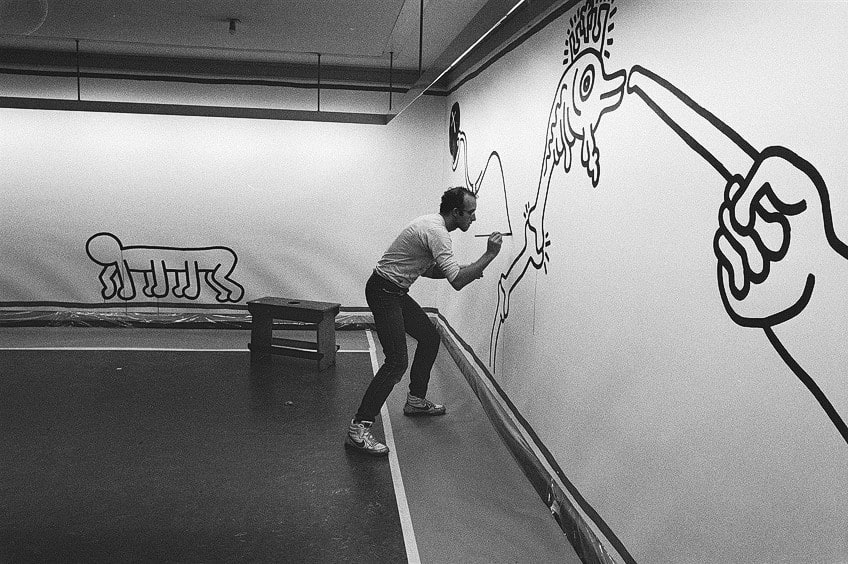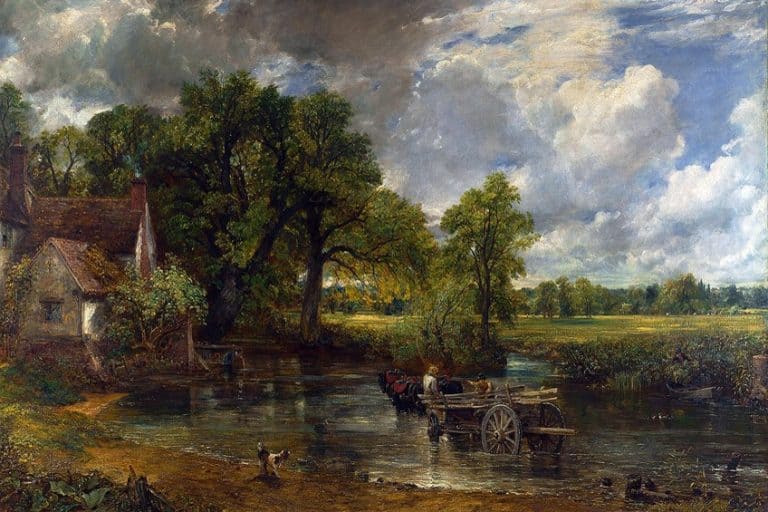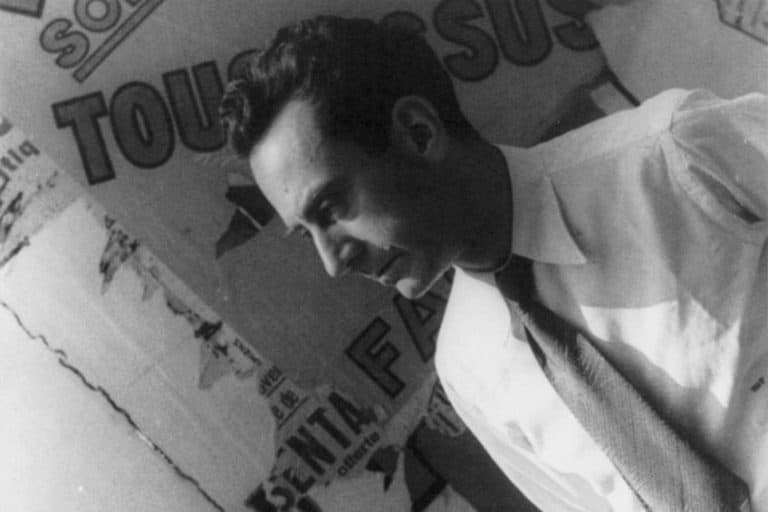“Barking Dogs” by Keith Haring – A Pop Art Phenomenon
Barking Dogs by Keith Haring is a quintessential example of the artist’s dynamic and accessible style, which emerged from the vibrant street culture of 1980s New York City. Created in 1985, this artwork features Haring’s iconic simplified figures and bold lines, depicting two animated dogs in motion. The piece exemplifies his unique ability to convey powerful social messages through deceptively simple imagery, often addressing themes of human rights, community, and the vibrant energy of urban life. Haring’s Barking Dogs is celebrated not only for its visual impact but also for its role in making art accessible to a broader public, breaking down barriers between high art and popular culture.
Key Takeaways
- Keith Haring’s Barking Dogs is an iconic and recognizable symbol in his body of work.
- Haring’s art was characterized by bold lines and vibrant imagery that addressed social issues.
- Collectors value Haring’s pieces for their historical significance and energetic expression.
The Iconography of Barking Dogs
Keith Haring’s Barking Dogs is among the most iconic images created by the renowned American artist. Known for his vivid graffiti-inspired drawings, Haring introduced a pictorial language that resonated across cultural boundaries.
Barking Dogs remains one of his most recognizable symbols, embodying Haring’s commitment to making art accessible to all.
The Barking Dogs motif, with its distinct and bold lines, was often seen in subway stations and later graced art galleries globally. Haring’s vibrant, energetic style brought attention to various social issues, reflecting his deeply rooted activism and his desire to reach diverse audiences. His work continues to inspire and provoke thought, underscoring his enduring legacy in contemporary art.

For art collectors, owning a piece like Barking Dogs means possessing a fragment of artistic history. Haring’s ability to infuse his drawings with vitality and profound meaning makes his artwork highly sought after. With numerous pieces available for purchase, collectors have the opportunity to own an emblematic part of Haring’s creative journey.
Meaning
The Barking Dogs represents more than just a playful depiction of animals. Haring’s use of the motif often speaks to themes of authority, control, and societal norms. The dogs, often shown in a state of alertness or aggression, can be seen as embodiments of both power and subversion. In various artworks, the Barking Dogs seem to challenge the viewer, provoking thoughts about conformity and obedience.
This duality highlights Haring’s ability to create layered meanings within seemingly simple images. The motif serves as both a critique and an observation of the human condition.
Inspiration and Origins
Haring’s Barking Dogs finds its roots in his fascination with semiotics and street art. Influenced by the visual language of comics and animated cartoons from his childhood, Haring developed a unique, accessible pictorial language. He studied semiotics at the New School, which informed his approach to symbolism and communication through imagery.

His drawings in New York City subways, particularly the Barking Dogs, became familiar symbols to commuters. This motif was part of his broader aim to democratize art, making it available to all, regardless of social status or background. The repetition of this figure across various public spaces underscores its importance in Haring’s oeuvre.
Symbolism of Barking Dogs
Haring’s Barking Dogs serves as a powerful symbol of both primal instincts and societal structures. The dogs, often depicted with animated, rubbery bodies, convey a sense of energy and urgency. This imagery reflects the artist’s views on the underlying animal instincts that persist in human behavior.
Moreover, the motif can be interpreted as a commentary on surveillance and control, with the barking dog symbolizing a watchful presence.
Its radiant vibrancy and recurring appearances in Haring’s work make it a captivating study in how simple forms can communicate complex ideas. This speaks to Haring’s genius in using minimalistic figures to convey rich, multi-layered messages.
Keith Haring’s Artistic Activism
Keith Haring’s artistic activism was deeply informed by his social and political concerns. His work touched on issues such as AIDS awareness and provided critical commentary on society and government.
AIDS Awareness
Keith Haring was a prominent figure in raising awareness about the AIDS crisis. He used his art to highlight the human impact of the disease, a subject that was often stigmatized. Haring’s own life was affected by AIDS, and he sought to break the silence around the epidemic through his visuals. His foundation, the Keith Haring Foundation, was established in 1989 to support organizations working in education, research, and care related to AIDS.
Haring’s murals and public art projects often featured imagery that promoted safe sex and compassion for those affected by the disease.
Haring’s Barking Dogs, while not explicitly about AIDS, is deeply connected to the artist’s broader body of work and activism around the AIDS crisis. Created during the height of the epidemic in the 1980s, Haring’s bold, dynamic imagery and public art initiatives often addressed urgent social issues, including AIDS awareness.

The relentless energy and sense of urgency conveyed in Barking Dogs mirror Haring’s own advocacy for AIDS education and prevention, using his art to amplify the message of compassion and action. Through his foundation and numerous works, Haring tirelessly campaigned for greater awareness and support, making Barking Dogs emblematic of his commitment to using art as a vehicle for social change and health advocacy.
Society and Government Commentary
Haring’s work frequently offered a critique of various social and governmental issues. He was an outspoken critic of apartheid in South Africa and American governmental policies. Through his art, he addressed themes such as nuclear disarmament, human rights, and systemic injustice.
The Barking Dogs motif is one example, symbolizing a defiant stand against abuses of power.
Haring’s vibrant, accessible style made his commentary widely relatable, helping to inspire a generation to engage with these critical issues. His Pop Shop, opened in 1986, was another vehicle for disseminating his activist messages to a broader audience, making art, and its inherent social critique, accessible to people beyond the traditional gallery setting.
Collecting Keith Haring’s Work
Collecting the works of Keith Haring, particularly his Barking Dogs pieces, involves understanding market trends, valuation metrics, and acquisition strategies suitable for collectors and galleries. Key factors include price estimates, the nature of the editions, and the significance of signed or numbered works.
Market Performance and Valuation
Keith Haring’s artworks, such as the Barking Dogs, have seen consistent demand in the art market. Both limited edition pieces and unique works have performed well, often exceeding their estimates. Signed items and pieces from repeated sales indicate premium performance.
Works with provenance or those that include a certificate of authenticity tend to attract higher valuations.
Acquisition for Collectors and Galleries
Acquiring Haring’s work can be a strategic endeavor. For individual collectors, focusing on recognizable images like the Barking Dogs” can be both a cultural investment and a fiscal one. Galleries benefit from showcasing iconic pieces, often drawing increased visitation and interest.

When assessing potential acquisitions, examining factors like edition size, condition, and historical overperformance is crucial. Graph data can be particularly useful for premium subscribers tracking sales trends over time. Additionally, works on paper versus canvas can affect value, and acquiring pieces directly from reputable auction houses or established galleries ensures authenticity.
Keith Haring’s Barking Dogs remains a powerful testament to his artistic vision and commitment to social activism. The artwork’s vibrant, energetic lines and universal symbols encapsulate the spirit of 1980s urban culture while addressing broader themes of communication, power, and societal issues. Through Barking Dogs, Haring’s legacy endures, reflecting his belief that art should be inclusive, accessible, and impactful. This piece not only exemplifies Haring’s distinctive style but also underscores his role in transforming public spaces into canvases for cultural dialogue, making a lasting mark on the art world and beyond.
Frequently Asked Questions
What Is the Symbolism Behind Keith Haring’s Barking Dogs Artwork?
Keith Haring’s Barking Dogs prominently features a stylized dog with its mouth open. This imagery often represents resistance, communication, and social activism. Created during a period marked by political and social change, the Barking Dog challenges authority and advocates for marginalized voices.
Where Can One Purchase a Keith Haring Barking Dog Print?
Keith Haring’s Barking Dog prints are available through various art galleries and online platforms. Websites like masterworksfineart.com and artsy.net often have these prints for sale. Collectors should ensure the authenticity of the artwork by purchasing from reputable sources.
How Do the Barking Dogs Relate to Keith Haring’s Broader Work?
The Barking Dogs are intricately tied to Haring’s larger body of work, which emerged from the New York graffiti scene in the 1980s. His art frequently addresses themes of social justice, identity, and community, with the energetic and vibrant style that characterizes his entire portfolio.
Can You Explain the Significance of Dogs in Keith Haring’s Artistic Expression?
Dogs are recurring figures in Keith Haring’s art, symbolizing loyalty, vigilance, and activism. The Barking Dogs, in particular, reflect themes of resistance and the artist’s commitment to making art accessible to all. Haring saw his work as a way to communicate important social messages to a wide audience.
Isabella studied at the University of Cape Town in South Africa and graduated with a Bachelor of Arts majoring in English Literature & Language and Psychology. Throughout her undergraduate years, she took Art History as an additional subject and absolutely loved it. Building on from her art history knowledge that began in high school, art has always been a particular area of fascination for her. From learning about artworks previously unknown to her, or sharpening her existing understanding of specific works, the ability to continue learning within this interesting sphere excites her greatly.
Her focal points of interest in art history encompass profiling specific artists and art movements, as it is these areas where she is able to really dig deep into the rich narrative of the art world. Additionally, she particularly enjoys exploring the different artistic styles of the 20th century, as well as the important impact that female artists have had on the development of art history.
Learn more about Isabella Meyer and the Art in Context Team.
Cite this Article
Isabella, Meyer, ““Barking Dogs” by Keith Haring – A Pop Art Phenomenon.” Art in Context. July 17, 2024. URL: https://artincontext.org/barking-dogs-by-keith-haring/
Meyer, I. (2024, 17 July). “Barking Dogs” by Keith Haring – A Pop Art Phenomenon. Art in Context. https://artincontext.org/barking-dogs-by-keith-haring/
Meyer, Isabella. ““Barking Dogs” by Keith Haring – A Pop Art Phenomenon.” Art in Context, July 17, 2024. https://artincontext.org/barking-dogs-by-keith-haring/.











